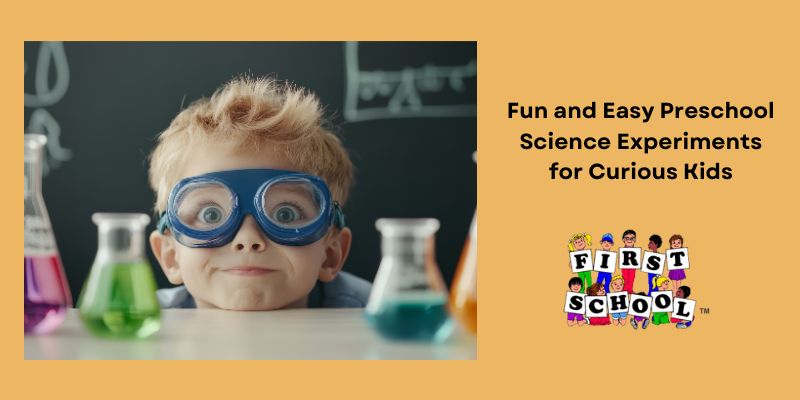



Ever notice how preschoolers seem to be tiny scientists already? They poke, pour, mix, and ask, “What happens if…?” That’s science in action! With the right activities, you can turn their everyday curiosity into exciting discoveries. These fun and easy preschool science experiments not only keep little hands busy but also build critical thinking and a lifelong love of learning.
This blog shares fun and easy science experiments that help preschoolers explore, learn, and grow.
Science isn’t just about beakers and lab coats, it’s about exploring, questioning, and discovering. Introducing fun science activities for preschoolers at an early age builds essential skills that support overall development:
Before you break out the food coloring and baking soda, take a few precautions:
You don’t need a lab to spark excitement, just a few everyday items and a sense of wonder.
Materials: 6 clear cups, water, paper towels, food coloring
Concept: Capillary action and color mixing
Fill three cups with water and add red, yellow, and blue food coloring to each. Place empty cups between the colored ones. Fold paper towels into strips and place one end in each cup so they bridge the gaps. Watch as the colors “walk” up and over into the empty cups, creating new colors!
What kids learn: Liquids move through paper (capillary action) and how colors blend.
Materials: Baking soda, vinegar, dish soap, food coloring, small container
Concept: Chemical reaction
Add a spoonful of baking soda into a container. Mix vinegar with a drop of dish soap and food coloring, then pour it in. Instant fizz and colorful “lava”! For extra fun, build a small volcano model with clay or dough.
What kids learn: Acid-base reactions cause bubbling and fizzing.
Materials: Large bowl or tub of water, household items (toy, coin, sponge, spoon)
Concept: Density and buoyancy
Ask your child to guess (predict) whether each item will sink or float, then test and see. Talk about why some items float while others sink.
What kids learn: Objects behave differently in water based on their weight and material.
Materials: Milk, food coloring, dish soap, cotton swabs
Concept: Surface tension
Pour milk into a shallow dish, add drops of food coloring, then dip a dish-soap-covered cotton swab into the milk. Watch the colors swirl and dance!
What kids learn: Soap breaks the surface tension of milk, causing the colors to move.
Materials: Ziplock bag, wet paper towel, dry bean (like a kidney or lima bean)
Concept: Plant life cycles
Place the bean on a moist paper towel in a clear bag and tape it to a sunny window. In a few days, roots and sprouts will appear! Let kids draw or photograph changes daily.
What kids learn: How seeds grow into plants through germination.
Keep kids excited and curious with a few creative approaches:
Science is everywhere, hidden in your kitchen, backyard, or classroom. With just a few items and a little creativity, these easy science experiments for preschoolers can unlock a world of learning.
They not only entertain but teach valuable skills like observing, predicting, and experimenting. Most importantly, they show children that science isn’t intimidating, it’s exciting, colorful, and full of wonder.
Curious minds grow at First School! With hands-on science activities and fun-filled discovery, we help preschoolers explore, ask questions, and learn through play. Ready to nurture your child’s love for learning?
Enroll your child and watch them grow!